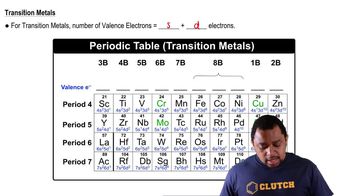Textbook Question
(b) How many valence electrons does a nitrogen atom possess?
700
views




(b) How many valence electrons does a nitrogen atom possess?
(c) An atom has the electron configuration 1s22s22p63s23p2. How many valence electrons does the atom have?
(a) True or false: The hydrogen atom is most stable when it has a full octet of electrons.
(a) Write the electron configuration for the element titanium, Ti. How many valence electrons does this atom possess?
(b) Hafnium, Hf, is also found in group 4. Write the electron configuration for Hf.
(c) Ti and Hf behave as though they possess the same number of valence electrons. Which of the subshells in the electron configuration of Hf behave as valence orbitals? Which behave as core orbitals?